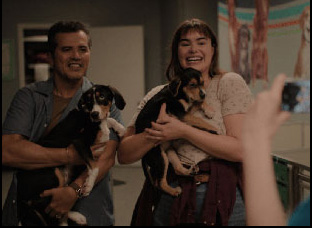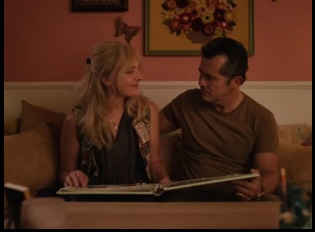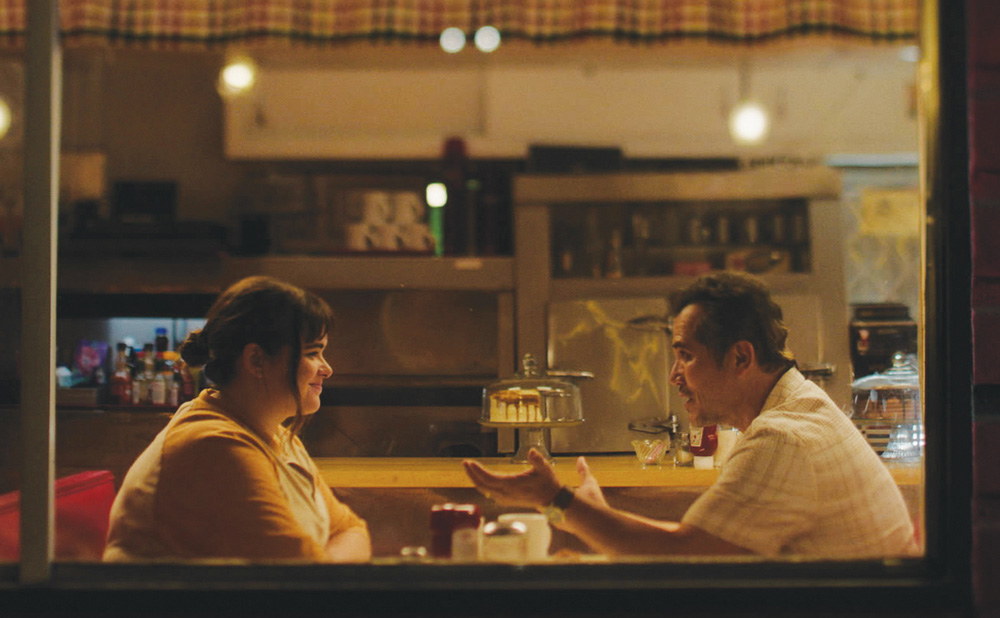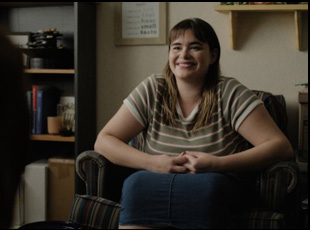Tracie Laymon had been ready for a while to make her first feature to go by skill, honing her craft on shorts and episodic series for some time, but the right story proved more elusive.
“I think part of it was that this one I really had something to say. The other features I had written I really wanted to say them, but I didn’t need to, and they won awards or people liked them in workshops and things like that. Some of them got optioned or cast, but they didn’t get made,” Laymon recalls before she committed to making “Bob Trevino Likes It.” “This one, it was too important to me for it not to get made. I didn’t want it winding up on a slate somewhere when I had it within me had to say it, and I just got Sean Mullin, my producing partner who helped me put it all together, and we just made it ourselves.”
“Bob Trevino Likes It” is a film only Laymon could’ve made, in part because of the real-life inspiration behind it in which the filmmaker’s efforts to reconnect with her estranged father over the Internet inadvertently led to a rewarding friendship with a stranger who shared the same name. However, the film also mixes a soulfulness and sprightly sensibility that one senses is also distinct to the writer/director who observes a beautiful relationship unfold between a young woman named Lily (Barbie Ferreira) and Bob (John Leguizamo), a middle-aged construction contractor who can be surprised to get a notice on his little-used Facebook account. The chat request was intended for her biological father Bob (French Stewart), who only contacts Lily when he needs money or to serve as a prop for a date he wants to impress, but the strangers end up making a connection in their shared loneliness when Lily could use a compassionate ear and Bob the builder could use somebody to talk to, having a loving but uneventful marriage with his wife Jeanie (Rachel Bay Jones), who prefers piecing together old memories in her scrapbooks rather than making new ones.
Soon Bob is saying “I can’t remember the last time I drank a cup of coffee this late,” sitting across from Lily when their conversation moves offline to IRL talking into the wee hours of the night at a local diner, but it isn’t just the caffeine that brings about a new energy for the pair who are able to unlock something in one another once they have someone to confide in. The remarkable story behind “Bob Trevino” could threaten to overtake what a marvelous debut it is when Laymon was pushed to move forward with the film when plans to make a short version were scuttled upon learning after finishing the script that the real Bob she connected with over the internet had passed away unexpectedly and a full feature came spilling out. There could be no better tribute to what people can offer with a simple, kind gesture than the film Laymon ultimately made, which won over one audience after another since its premiere at SXSW and picking up honors in Mill Valley, Tallgrass, Nashville, Hamptons and Denver. Now with “Bob Trevino Likes It” opening in theaters across the country, Laymon spoke about all the care she put into crafting such a touching and tender comedy, from taking great pains in casting and scheduling to put everyone in the best place to succeed to filling the film with elements of her own life that she knew might mean something to someone else.
When it did come from a personal place, what was it like to start placing it in the hands of others as far as actors?
Yeah, I always had skin in the game. It was a very personal, vulnerable story to me, but I was also really open and I really, really looked very, very hard for the right people and I was open to the wonderful things they were going to bring from their life experiences. You cast the cast, but you also cast the crew, so every single member of the team, it was about finding the right person and was a real Venn diagram with every collaboration of my emotional truth, my experiences, what I had written, and what other people were bringing. I found that we really had a lot of similar experiences and you’d think specificity would make it less [relatable], but there’s so much truth to specificity as universal and I had never experienced that much until this film where I was so specific and so honest, everybody could relate in some way, and bringing their truth to it. Whether that was Barbie [Ferreira], who was first actor on, an executive producer of the film, and just an incredible, incredible human being, all the way down to the interns, everybody brought so much.

A couple of different casting directors have said that I do more work than any other director before we make an offer to an actor, and I think that’s because I don’t really believe in these lists of actors. I understand they’re part of the process, but I really believe that I’m looking for the one person that is meant to play each role and that takes a lot of digging and paying close attention to not only their prior work, but moments and beats of things that they should have opportunities to show more of. Sometimes there’ll be a line in an interview like this and they throw it away, and I’m like, “Wait, that’s the most important thing right there, that insight into who you are or what you want to do.” So it’s a great privilege to be able to collaborate with people and find ways that they get to show these sides of themselves. I don’t want to do things that have already been done, and I don’t believe in boxing people in life, so I don’t want to do it in my films either.
I’ve heard you rejiggered the whole schedule so Barbie could have the base memory of what sitting across from her father, played by French Stewart, was like. What was it like to facilitate something like that for the performance?
Yeah, we didn’t have a lot of rehearsal time and we were really low budget, but I knew we were going to shoot the scenes with John [Leguizamo] and Barbie scenes first, but I knew that I needed to rehearse French and Barbie before Barbie or any actor would fully know what it was like. It would help inform the decisions with the new Bob, with John Leguizamo, to have something in you from experiencing something with the bad Bob. So I said, “Y’all, I know John’s up first, but we need to fly French in and rehearse those scenes qith Barbie.” And we didn’t have a lot of money, so it was a real decision on my part, but I pushed for it and French was willing to come out, rehearse with Barbie, fly back, then we flew John in, and then we shot with John, and then John left and we flew in French. I had to also improv the highs as well with French because I needed to improve the moments of connection between Lily and her dad as well. Like she’s not a doormat. She’s smart. She has to be going for something that was worthy. It can’t just all be bad, but at the same time you need that in you.

I feel like I was a little bit of a matchmaker and I just paid such close attention to everybody’s work individually. I really feel like I knew it was going to work, but it worked even better than I had hoped because when we sat down for the rehearsals with French and Barbie, it was magic. They don’t even look that much alike, but you just buy everything. You buy the history because they’re such incredible actors. And then when Barbie and John sat down for rehearsal, it was like magic yet again and Mike Nichols had this quote, “If you want an actor to go somewhere, be willing to go there first, so I was vulnerable with the story.” So I thought, “You’re not alone. I’m going to be open, I’m going to be vulnerable and I’ve got your back, so we’re all in this together,” and they all showed up completely as themselves and brought so much of their own choices, decisions, and history to these characters.
One of the more subtle signs of life in this is in the production design, where it feels quite grounded but has a lot of energy to it because of the color and how detailed it is. What was it like to work on?
Sydney Marquez was the production designer and she’s incredible. I interviewed a lot of production designers and Sydney was the only one that I felt really got it. A lot of people were doing digital mood boards for their interview and at first, I saw a scan and I thought, “These are so great. They almost feel real,” and I [realized] she went to the store and got physical boards and made them and showed them to me on the Zoom. And that’s really what this movie is. It’s going from digital to analog or social media to in-person connections, so for her to have physically gotten those boards and made these things [was amazing]. And I told every department that I wanted primary colors as much as possible. There’s a real innocence to that and a playfulness, so we looked at “Little Miss Sunshine” and “Eighth Grade” and movies that I felt had color, even though they dealt with tough things.

One of my childhood best friends, her mom was a scrapbooker growing up and she’s an expert scrapbooker. I wound up in some of their family albums and I don’t know if my friend was as much in awe of her mom’s scrapbooking as I was, but I thought it was so special and I never forgot it. She ended up being our scrapbook consultant on the film and just came to our screening in Houston. So it’s something that I had seen early on and I don’t know if I was influenced by it or not, but I really loved the film “Amelie.” They had scrapbooks in the credits and I just love the innocence [of it] and the idea that every photo and every moment matters so much that we’re going to preserve it forever. There’s something to the tactile nature of it, especially now when it’s so much of our stuff is online and digital.
It makes me wonder how much you can actually look back on this as a scrapbook of your own when I understand there were a number of friends and family involved in the production.
Yeah, throughout my life, I tried to pay really close attention to the humanity around me – what I go through and things people that I care about go through and I hold onto that stuff. Even though this is a work of fiction, I feel there’s a truth to grieving parents, and to people feeling like they don’t belong. There’s truth to father figures, a lot of truth in my life to father figures that weren’t my father. Bob Trevino is an amalgamation of both the Facebook dad that I found and a guy named Bob Trevino in Texas who has been a mentor to me for a very long time. And as a director, I wanted to be able to share these stories from my life and the actors could know that this isn’t just completely made up. This is a universal experience. This is something that is real and that a lot of us go through.
The baby in the book is my friend’s child that they lost and they agreed to let us use those photos because they figured if his life could help one other set of parents heal, then they wanted to be a part of it. And he just saw the movie the other day and texted me last night and said that it was beautiful and that it really helped him. I’m hearing that it’s helping other parents as well. I think we’re in a loneliness epidemic right now too, and coming out of the pandemic and with as much as social media is dividing us, I think there’s a real desire to connect and to feel our shared humanity. and I really feel like there’s something for everybody in here.
And I didn’t know that it was going to have this kind of impact emotionally. You hope that it does, but how do you know? You just do your best. And it is really beautiful to hear these stories of all these people that can relate. I thought I had already done my healing in the lived experience here, but then here I am at these screenings or looking online and people are saying their stories and how it helped them heal. There’s a cathartic release with that as well – that this story is not just my story, but now our story and I get to release it in a way and turn my pain into art. That’s something I don’t think I’ve ever experienced at this level before and I’m just so grateful that it’s happening.
“Bob Trevino Likes It” is now in theaters and expanding across the country. A full list of theaters is here.





